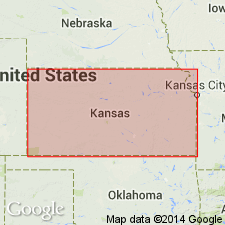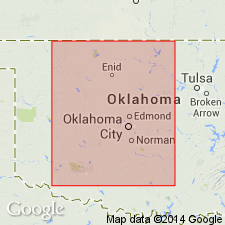
- Usage in publication:
-
- Wellington shales
- Modifications:
-
- Named
- Dominant lithology:
-
- Shale
- Limestone
- Gypsum
- Dolomite
- AAPG geologic province:
-
- Sedgwick basin
Summary:
Named as the upper formation of two formations of Sumner division (new) of Big Blue series (new) for town of Wellington, Sumner Co, KS in the Sedgwick basin. No type locality designated. Overlies the Geuda salt measures (new) of Sumner division. Underlies Harper sandstones (new) of Salt Fork division (new) of Cimarron series. Consists of bluish-gray clay shale 250 to 450 ft thick. Clay is mottled red and green-gray in lower part. Also includes impure limestone, calcareous shale and occasional gypsum and dolomite beds. Provisionally includes a hard, gray, cellular dolomite near the Little Arkansas River. Permian age.
Source: GNU records (USGS DDS-6; Denver GNULEX).

- Usage in publication:
-
- Wellington formation
- Modifications:
-
- Revised
- AAPG geologic province:
-
- Chautauqua platform
- Anadarko basin
Summary:
Revised as a formation (1 of 6) of Enid group (raised in rank). Occurs in north-central OK on the Chautauqua platform and in the Anadarko basin, and in adjoining KS. Consists of gray to bluish and drab shales with numerous thin beds of gray "mud-stone." Beds of red sandstone present at the "color-change line" changing the color of the shales from gray and drab to red. In KS lies on Pearl shale member of the Marion formation, but in OK the Pearl shale member cannot be readily differentiated from the Wellington and thus is mapped (geologic map) with the Wellington. In northern OK, thickness of the Wellington is approximately 600 ft and thickness of the Pearl is 70 ft. Overlies Stillwater formation and underlies the newly named Garber sandstone, both of the Enid group. Geologic map of north-central OK. Stratigraphic table. Of Permian age.
Source: GNU records (USGS DDS-6; Denver GNULEX).
For more information, please contact Nancy Stamm, Geologic Names Committee Secretary.
Asterisk (*) indicates published by U.S. Geological Survey authors.
"No current usage" (†) implies that a name has been abandoned or has fallen into disuse. Former usage and, if known, replacement name given in parentheses ( ).
Slash (/) indicates name conflicts with nomenclatural guidelines (CSN, 1933; ACSN, 1961, 1970; NACSN, 1983, 2005, 2021). May be explained within brackets ([ ]).

